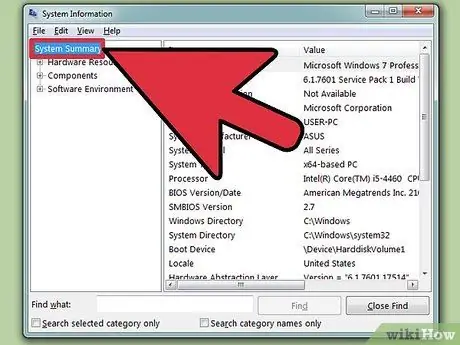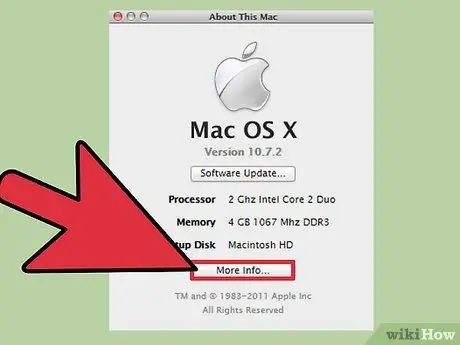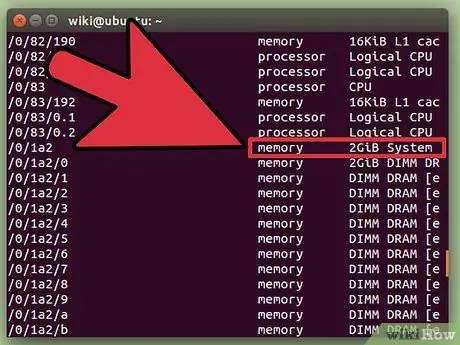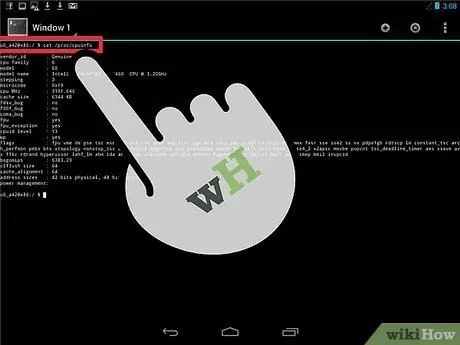- Author Jason Gerald [email protected].
- Public 2024-01-15 08:07.
- Last modified 2025-01-23 12:04.
By knowing the specifications of your computer, you can make a decision whether to buy software and hardware or not. By knowing this, you can also narrow down the possible technical problems you may encounter when you know all the hardware models used. You can quickly find specifications for any operating system.
Step
Method 1 of 4: Windows

Step 1. Open the Run dialog
You can find the Run dialog in the Start menu or by pressing Win+R.

Step 2. Type
msinfo32, then press Enter. This will open the System Information window.
- You may need to wait a while for the window to open.
- There are several ways to check system specifications in Windows, but System Information provides the most comprehensive report in one place.

Step 3. Review the System Summary section to find basic information about the computer
There are a few noteworthy notes within the System Summary screen, and this section opens immediately when the System Information window is launched.
- OS Name - This is the Windows version you are using.
- System Manufacturer/Model - This is the name of the computer manufacturer and computer model.
- System Type - This section indicates whether you are running a 32 bit (x86) or 64 bit (x64) version of Windows.
- Processor - This is information regarding your processor model and speed. The speed listed here corresponds to the speed of the processor when advertised. If your processor has dual cores, the number of cores will be shown in this section. Be aware that if you have overclocked your processor, the new results from that process will most likely not be shown here.
- Installed Physical Memory (RAM) - This is information about the RAM installed in the computer.
- Baseboard Manufacturer/Model - This is information about the manufacturer and model of the motherboard. Motherboard models may not always be detailed.

Step 4. Expand the "Components" section
In the Components section, you can see detailed information about the graphics card and hard drive.

Step 5. Select "Display"
In this section, the installed graphics cards will be displayed. If your motherboard already has its own graphics card and you install another graphics card, you will see two different graphics card specifications.
When you look at the specifications of a graphics card, the most common thing you should know is the Name and RAM Adapter. RAM adapters are shown in bytes, but are usually listed in gigabytes (GB) in the system requirements. There are about a billion bytes in a gigabyte (Windows will display a different number than the number displayed by the device manufacturer).

Step 6. Expand the "Storage" section, then select "Drives"
In this section, the amount of remaining space and the total hard disk capacity of all mounted disks and partitions will be displayed.
Select the "Disks" option to view information about the mounted hard disks and the partitions shared on each disk

Step 7. Explore other sections
The above information should be sufficient to use in determining whether your computer's specifications are sufficient to meet the requirements of a particular software or hardware system. The information above is basic information, and you can find more detailed information in each note.
The "Software Environment" section will display all drivers, running processes, and programs that are activated when Windows starts (startup programs)

Step 8. Select the option to export the specification file for use in troubleshooting
If you are working with a technician to troubleshoot a computer problem, the technician may need to see a document regarding your computer's specifications. You can export system specifications by clicking the "File" menu and selecting "Export". Give the file a name, and it will be saved as a text file.
Method 2 of 4: Mac

Step 1. Click the Apple menu and select "About This Mac"
This will open a window showing your version of OS X and a summary of the computer's system specifications. Within the window, the information displayed includes processor speed, memory (RAM), and graphics adapter (if installed).

Step 2. Use the tabs at the top of the window (Yosemite)
In the latest versions of OS X, there are tabs at the top of the About This Mac window, so you can move from one hardware category to another quickly. If you are using an OS X Mavericks system (OS X 10.9) or earlier, continue to the next step.
- Within the Overview tab, a brief summary of the information related to the specifications you search for most frequently is displayed. This page alone should be sufficient to determine whether the computer meets the requirements to run a program or not.
- The Displays tab will show all the screens connected to your computer.
- The Storage tab will display information about your hard disks and information about the remaining space on each disk.

Step 3. Click
More Info (Mavericks or earlier). This way, a window with detailed hardware information will be displayed. Use the navigation tree on the left to find the hardware you want to check.
- The Hardware section will display detailed information about all of your hardware components. When you select "Hardware", information about your processor will be displayed in the right frame. If your processor has more than one core, the processor cores will be listed in this section.
- Note: In this section, the processor speed displayed corresponds to the advertised processor speed, and this information is validly used to determine whether the computer meets the requirements necessary to run a program. However, information from overclocking the processor will not be displayed.
Method 3 of 4: Linux

Step 1. Open a terminal on the computer
You can use a lightweight program that provides hardware information that is included in many shared versions of Linux. If you don't have such a program, you can easily install one. You can open a terminal in most versions of Linux by pressing Ctrl+Alt+T.

Step 2. Install lshw (if needed)
Lshw is included in many shared versions of Linux, for example Ubuntu and Mint. Use one of the following commands to install lshw. If you already have it, you will be notified that lshw is installed.
- Debian - sudo apt-get install lshw
- Red Hat/Fedora - sudo yum install lshw

Step 3. Run lshw to see a record of the installed hardware
Use the following commands to hide the unimportant stuff and show only the most searched sections:
sudo lshw -short

Step 4. Find the hardware you are looking for
Use the "Class" column to find the hardware you want. You can find the processor, memory (RAM), graphics card ("display"), and disc volume.

Step 5. Create a text file containing your hardware specifications
Text files will be useful if someone is helping you with a computer problem or if you want to sell your computer.
- Type in sudo lshw -short > specs.txt. You can rename the file to anything. You can find the text file in the /home folder.
- You can also type sudo lshw -html > specs.html. This way, the computer's specifications will be loaded into an HTML file which may be easier to read when opened in a web browser.

Step 6. Install the GUI (Graphic User Interface)
This way, you can see the hardware in a graphical window that you can browse. This might make it easier for people who have previously used Windows or OS X.
- Type in sudo apt-get install lshw-gtk (Debian) or sudo yum install lshw-gui (RH/Fedora).
- Type sudo lshw -X to launch the Ishw GUI. The Ishw GUI uses a "3-frame" collation. When you expand something in the left frame, its subsections appear in the right frame. Try to expand the various types of categories to find the specifications of your computer.
Method 4 of 4: Android

Step 1. Download a terminal emulator
While you can use the Settings menu to find basic information about your phone, you won't be able to see more detailed information about the processor or memory. With a terminal emulator, you can use Linux commands to display your phone's system specifications.
If you can access the Developer Tools on your device (Settings → Developer Tools), you can launch the terminal emulator from there. If you can't access Developer Tools, you can download a terminal emulator app. The most popular free terminal emulator is "Terminal Emulator for Android". You can download it from the Google Play Store

Step 2. Open Terminal Emulator
You will be taken to a Linux-style command terminal.

Step 3. Type
cat /proc/cpuinfo, then press Enter. This way, information about the mobile processor inside the Android device will be displayed.

Step 4. Type
cat /proc/meminfo, then press Enter. This way, information about the memory (RAM) of the device is displayed, including the total amount of memory and the amount of memory currently in use.






